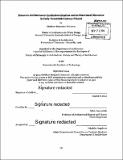Between architectures : institutionalization and architectural discourse in early twentieth-century Poland
Author(s)
Matteson, Matthew Benjamin
DownloadFull printable version (36.91Mb)
Other Contributors
Massachusetts Institute of Technology. Department of Architecture.
Advisor
Mark Jarzombek.
Terms of use
Metadata
Show full item recordAbstract
This dissertation explores the development by architects in interwar Poland of new epistemological approaches responsive to the challenges of modernity and modernization in the early twentieth century. It probes the establishment of institutional structures in higher education, publishing, and corporate life, investigating their development in relation to concomitant evolution of discourses around the role of history, architectural pedagogy, the social role of the architect, and the legal status of the architecture profession - crucial matters at the limen between the romantically glorified past and gloriously hopeful future. I argue that the robust intellectual currency ultimately shared among architects across the newly reconstituted Polish state facilitated challenges to long-standing narratives of romantic nationalism thus paving the way for a reconstruction of collective identity and consequently sophisticated contributions to cultural modernity and economic modernization. Presenting this largely untold story contributes to reevaluation of the genesis, development, and impacts of modernist culture in ostensibly peripheral locals, such as Central Europe, revealing these phenomena to be more pluralistic and nuanced than canonical historiography of modernism suggests. I present the construction of this institutional and epistemological armature as a process in three phases, with a segment of the developing network taking the leading role in each. Chapter one provides historical context and outlines a model of theory change developed by Ludwik Fleck in which social forces with particular historical contours are embodied in institutions crucial to the development of characteristic "thought styles" underlying the persistence of unique "thought collectives." Chapter two explores the newly formed Department of Architecture at the Warsaw University of Technology, showing how its faculty and students worked to form themselves into an intellectual community reimagining the historical and aesthetic foundations of Polish architecture. Chapter 3 addresses strategies for communication deployed in Polish architectural journals, where the articulation of a disciplinary identity for architecture as professionalized occupation, cultural phenomenon, and intellectual project was presented for both practitioners and a broader public. The final chapter focuses on architects' negotiation of conflicts both internally between generational groups and externally against peer engineers in the marketplace to formalize the corporate and legal organization of their profession.
Description
Thesis: Ph. D. in Architecture: History and Theory of Architecture, Massachusetts Institute of Technology, Department of Architecture, 2014. Cataloged from PDF version of thesis. Includes bibliographical references (pages 265-287).
Date issued
2014Department
Massachusetts Institute of Technology. Department of ArchitecturePublisher
Massachusetts Institute of Technology
Keywords
Architecture.